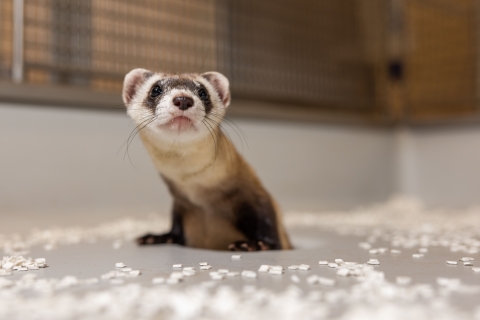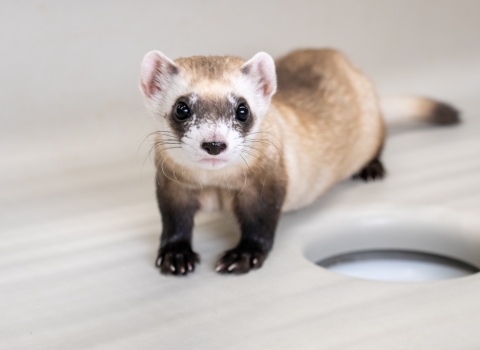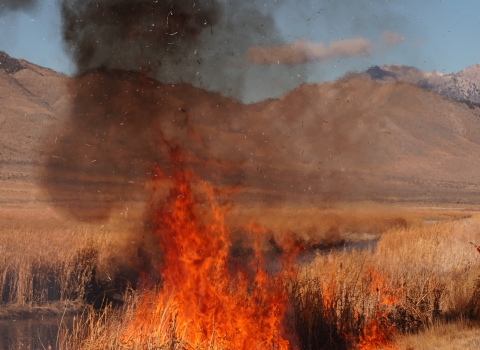DENVER — The U.S. Fish and Wildlife Service and conservation partners are excited to announce a groundbreaking achievement in endangered species research: the first-ever birth of black-footed ferrets produced by a cloned endangered animal. This historic event, a testament to the importance of conservation partnerships, occurred at the Smithsonian National Zoo and Conservation Biology Institute (NZCBI) in Front Royal, Virginia.
Antonia, a cloned black-footed ferret, has successfully given birth to two healthy offspring after mating with Urchin, a 3-year-old male black-footed ferret at Smithsonian’s NZCBI. This marks the first time a cloned U.S. endangered species has produced offspring, showcasing a critical step forward in using cloning to enhance genetic diversity in conservation efforts. While one of the three kits passed away shortly after birth, two—one male and one female—are in good health and meeting developmental milestones under the care of NZCBI carnivore keepers. Antonia and her kits will remain at the facility for further research, with no plans to release them into the wild.
“The successful breeding and subsequent birth of Antonia's kits marks a major milestone in endangered species conservation,” said Paul Marinari, senior curator at the Smithsonian's NZCBI. “The many partners in the Black-footed Ferret Recovery Program continue their innovative and inspirational efforts to save this species and be a model for other conservation programs across the globe.”
Research partners cloned Antonia using tissue samples collected in 1988 from a black-footed ferret named Willa, whose genetic material was preserved in the Frozen Zoo at the San Diego Zoo Wildlife Alliance. Partners at Revive & Restore and ViaGen Pets & Equine have pioneered this technology. Willa’s samples contain three times the genetic diversity seen in the current population of black-footed ferrets, all of which (except the three clones and new offspring) are descended from just seven surviving individuals. Introducing these previously unrepresented genes could play a key role in increasing the species’ genetic diversity, vital to healthy, long-term recovery.
The successful reproduction of a cloned endangered species is a landmark in conservation genetic research, proving that cloning technology can not only help restore genetic diversity but also allow for future breeding, opening new possibilities for species recovery. This represents a significant step in safeguarding the future of black-footed ferrets and overcoming the genetic challenges that have hindered recovery efforts.
This scientific achievement is the result of collaboration between the U.S. Fish and Wildlife Service and partners such as the Smithsonian’s NZCBI, Revive & Restore, San Diego Zoo Wildlife Alliance, ViaGen Pets & Equine, and the Association of Zoos and Aquariums. Cloning offers an important tool in addressing genetic bottlenecks and disease threats, such as sylvatic plague and canine distemper, that complicate recovery efforts for black-footed ferrets.
While this technology represents a promising new approach, it is one of many strategies being employed to aid species recovery. The Service continues to focus on habitat conservation, disease management, and the reintroduction of ferrets into the wild. Ongoing efforts include the development of disease resistance and habitat restoration across the Great Plains in collaboration with states, tribes, landowners, and other conservation partners.
For more information on black-footed ferret conservation, visit the U.S. Fish and Wildlife Service’s National Black-footed Ferret Conservation Center.
_______________________________________________________
Media contacts:
U.S. Fish and Wildlife Service: Joe Szuszwalak, joseph_szuszwalak@fws.gov
Smithsonian’s National Zoo & Conservation Biology Institute: Annalisa Meyer, meyeran@si.edu
San Diego Zoo Wildlife Alliance: Jake Gonzales, jgonzales@sdzwa.org
Association of Zoos & Aquariums: Sarah Fedele, sfedele@aza.org
Revive & Restore: Elizabeth Bennett, elizabeth@reviverestore.org
ViaGen Pets: Lauren Aston, lauren.aston@viagenpets.com
The U.S. Fish and Wildlife Service works with others to conserve, protect, and enhance fish, wildlife, plants, and their habitats for the continuing benefit of the American people. For more information, visit www.fws.gov and connect with us on social media: Facebook, Instagram, X (formerly known as Twitter), LinkedIn, Flickr, and YouTube.
Revive & Restore is the leading wildlife conservation organization promoting the incorporation of biotechnologies into standard conservation practice. The Sausalito, California nonprofit was formed in 2012 with the idea that 21st century biotechnology can and should be used to enhance genetic diversity, build disease resistance, facilitate adaptation and more. Its mission is to enhance biodiversity through the genetic rescue of endangered and extinct species. https://reviverestore.org/projects/black-footed-ferret/
ViaGen Pets & Equine is the worldwide leader in cloning the animals we love. We provide the option of hope through DNA storage of your unique dog, cat or horse. Then through our amazing cloning technology we provide joy to clients all over the world with a genetic twin to their original animal. Our team is dedicated to providing outstanding service, quality animal care and a love that lasts forever. ViaGen Pets and Equine is dedicated to conversation through partnership efforts with the San Diego Zoo and Revive & Restore. www.viagenpets.com
San Diego Zoo Wildlife Alliance is a nonprofit conservation leader, inspiring passion for nature and collaboration for a healthier world. The Alliance supports innovative conservation science through global partnerships and groundbreaking efforts at the world-famous San Diego Zoo and San Diego Zoo Safari Park, both leading zoological institutions and accredited botanical gardens. Through wildlife care, cutting-edge science and continued collaboration, more than 44 endangered species have been reintroduced to native habitats. The Alliance reaches over 1 billion people annually through its two conservation parks and media channels in 150 countries, including San Diego Zoo Wildlife Explorers television, available in children’s hospitals across 13 countries. Wildlife Allies – members, donors and guests – make success possible. www.sandiegozoowildlifealliance.org
The Smithsonian’s National Zoo and Conservation Biology Institute (NZCBI) leads the Smithsonian’s global effort to save species, better understand ecosystems and train future generations of conservationists. Its two campuses are home to some of the world’s most critically endangered species. Always free of charge, the Zoo’s 163-acre park in the heart of Washington, D.C., features 2,100 animals representing 400 species and is a popular destination for children and families. At the Conservation Biology Institute’s 3,200-acre campus in Virginia, breeding and veterinary research on 250 animals representing 20 species provide critical data for the management of animals in human care and valuable insights for conservation of wild populations. NZCBI’s more than 300 staff and scientists work in Washington, D.C., Virginia and with partners at field sites across the United States and in more than 30 countries to save wildlife, collaborate with communities and conserve native habitats. NZCBI is a long-standing accredited member of the Association of Zoos and Aquariums. https://nationalzoo.si.edu
The Association of Zoos and Aquariums (AZA), founded in 1924,is a nonprofit organization dedicated to the advancement of zoos and aquariums in the areas of conservation, animal wellbeing, education, science, and recreation. AZA is the accrediting body for the top zoos and aquariums in the United States and 13 other countries. Look for the AZA accreditation logo whenever you visit a zoo or aquarium as your assurance that you are supporting a facility dedicated to providing excellent care for animals, a great experience for you, and a better future for all living things. The AZA is a leader in saving species and your connection to helping animals all over the world. www.aza.org







